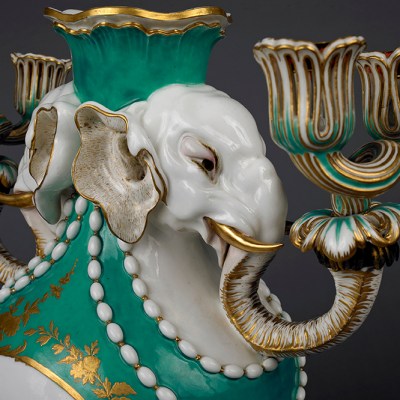With residences in London and Paris, a fortune amassed through the sale of hydrocarbons and an estate structured to frustrate the most persistent taxman, Calouste Gulbenkian invites comparison with that much-maligned figure of 2022, the oligarch. Yet Gulbenkian’s wealth went on nothing as ostentatious – not to mention illiquid – as yachts, chateaux and Mediterranean villas. His first purchase as a 14-year-old in late 19th-century Istanbul was a pair of ancient Greek coins, bought with the 50 piastres pocket money he had received from his father. Although this cosmopolitan oil dealer’s collection would later swell to include paintings, statuary and furniture, coins and other portable items – medals, carpets, gems and books – would remain at its heart. Beauty had to live with fungibility.
Gulbenkian was born in Istanbul in 1869 to Armenian parents. Educated in Marseilles and London, he began his career assisting his father, a kerosene trader, but soon acquired enough understanding of the petroleum business to make his own deals. The big one came in 1912, when he put together a consortium to develop and exploit the oil reserves of Mesopotamia, taking a share in the business. As demand for petroleum grew and the oil price rose over the decades that followed, Gulbenkian’s dividend went up and up. He established himself in western Europe, where he kept company with statesmen, captains of industry and doyens of the artistic establishment, among Joseph Duveen and Kenneth Clark. It was here that he set about building one of the finest private collections ever assembled.
Calouste Gulbenkian, photographed in c. 1925. Photo: Photo 12/Alamy Stock Photo

A select number of these are on display in the exhibition ‘Gulbenkian Revealed: In the Collector’s Private Realm’, organised by The Al Thani Collection and opening at the Hôtel de la Marine in Paris on 10 June. The exhibition represents a homecoming of sorts for Gulbenkian’s works. Many of the items on loan from the Calouste Gulbenkian Museum in Lisbon, their permanent abode, for a time inhabited the hôtel the oil trader bought on the Avenue d’Iéna in the 16th arrondissement in the 1920s. Hôtel it was in more ways than one. On acquiring the building, Gulbenkian, a long-term habitué of the Ritz, had the building gutted and furnished in the ornate Louis XVI style to which he’d grown accustomed during the years he’d spent living on the Place Vendôme.
Many of the pieces, inevitably, have a deep connection with France. The tables, chairs and bookcases Gulbenkian acquired to decorate his house, not to mention smaller objets – candlesticks, tureens, vases – were 18th-century products of the workshops supplying the French court. Gulbenkian had a weakness too for works by French painters, from Watteau and Robert to Manet and Degas. One of the few contemporary artists Gulbenkian patronised was the Parisian designer René Lalique: in the first decades of the 20th century, he acquired some two hundred pieces directly from his studio.
Yet for Gulbenkian nationality was ultimately of little consequence. More important was lineage. In Gulbenkian’s eyes, much of a work’s lustre came from its provenance. He seized the opportunity to buy pieces that had associations with royalty or esteemed connoisseurs, most notably in the late 1920s, when he negotiated with the Soviet government the purchase of paintings – including works by Rembrandt and Rubens – and silverware that had belonged to the Russian imperial family. A prized possession was a jasper and gold-lidded ewer with a particularly dazzling history: a product of the French royal workshops, it had been drawn by François Boucher and formed part of the famous Hamilton Palace collection before falling into the hands of Baron Henri de Rothschild, from whom Gulbenkian acquired it.
Installation view of the Calouste Gulbenkian Museum in Lisbon. Photo:M.Sobreira/Alamy Stock Photo

Gulbenkian placed himself in this lineage. His artworks, he said, were his ‘children’. Each piece was chosen personally by him and served as an expression of his own tastes – an offshoot, even, of his person. This patriarchal attitude helps explain why his collection ended up not in London or Paris, where it had spent much of its time, but Lisbon, the city in which Gulbenkian took up residence during the Second World War to capitalise on Portugal’s neutrality. He at first offered his works to the National Gallery, but negotiations foundered on the question of how the works would be displayed, Gulbenkian insisting that they be exhibited together and not integrated with the museum’s wider collection. Under the terms of his will, drawn up two years before his death in 1955, ownership of the items was transferred to a trust, which was charged with housing them in a single place. The Calouste Gulbenkian Museum, a low-rise brutalist edifice joshingly far from the donor’s rococo tastes, was the result.
A concern with lineage is reflected too in the types of art Gulbenkian acquired. There is nothing encyclopaedic about his collection: some genres proliferate; others are conspicuously absent. Works from the Ottoman Empire and the wider Islamic world – Syrian glassware, Turkish ceramics, Persian textiles and manuscripts – are in abundance, forming an obvious link to his origins in Istanbul. Then there are the 19 views of Venice by Francesco Guardi that this one-man merchant republic took pains to amass, the largest single hoard of such paintings anywhere. And, of course, there are the coins, the germ of his collection and the only part of it that travelled with him to Lisbon during the war, connecting across the millennia the man known as ‘Mr Five Per Cent’ to some of the earliest traders in Asia Minor.
‘Gulbenkian Revealed: In the Collector’s Private Realm’ is at Hôtel de la Marine, Paris from 10 June to 2 October 2022.


